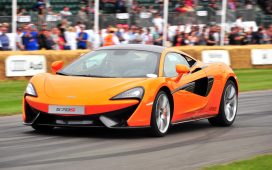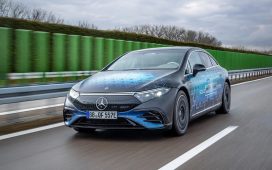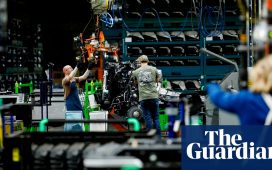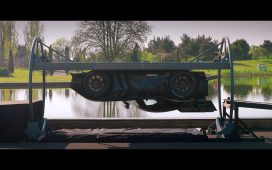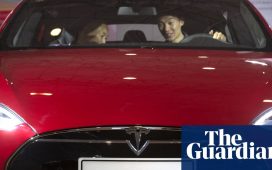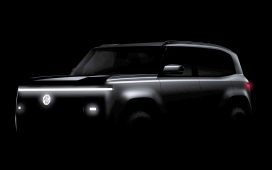“You can see that people are getting really serious about this. They’re starting to get it integrated into their production programs, and that’s what makes it really exciting,” says Jason Wallace of Hesai Technology. (Connor D. Wolf/Transport Topics)
[Stay on top of transportation news: Get TTNews in your inbox.]
LAS VEGAS — Trucking sensors are becoming an increasingly pivotal area of focus as an enabler of automotive technology, with that growing importance demonstrated at CES 2024.
CES, which was held Jan. 9-12, showcased a large range of automotive advancements with much of the focus on autonomous, electric and connected vehicles. But underlining those technologies was the importance of allowing vehicles to monitor their surroundings and internal systems. The methods displayed at the convention ranged from sensors, radar, sonar, lidar and cameras.
“There definitely is more interest in this technology,” said Jason Wallace, vice president of global marketing at Hesai Technology. “We work with nearly everybody outside of Waymo who makes their own sensors. But you can see that people are getting really serious about this. They’re starting to get it integrated into their production programs, and that’s what makes it really exciting — that it’s real. It’s not an R&D project.”
Hesai provides lidar solutions for autonomous mobility and advanced driver assistance systems (ADAS). That includes adaptive cruise control, blind spot monitoring and adaptive lane assist for heavy-duty commercial trucks. The approach uses lasers to determine the range of objects. Wallace believes the technology being integrated into production vehicles is driving the interest.
AT512 Ultra High-Performance Long-Range Lidar for ADAS. (Hesai Technology)
“I think that’s why people are getting more serious,” Wallace said. “How do we make things safer? What improvements can we make to the next generation of vehicles? Lidar adds that additional safety layer. So, I think that’s the biggest reason why we’ve seen that.”
Wallace also noted the technical requirements are making the technology more affordable and easier to integrate into vehicles. He sees the most immediate focus being on improving safety and ADAS systems and, longer term, the importance of driverless vehicles.
Hesai also recently announced its AT512 and ET25 systems to improve the range of its lidars.
“Valeo has the most comprehensive ADAS and AD solution portfolio in the industry,” said Jeffrey Shay, group president for North America at Valeo. “It starts with our full sensor suite, whether it be a smart front camera or a satellite surround view camera suite; radar and ultrasonic for low speed and parking maneuvering.”
Valeo is an automotive technology developer with a focus on smart mobility and reducing emissions. The company was founded on the belief electrification, autonomous and digitally connected vehicles represented three revolutions that will redefine the automotive sector. It has been primarily focused on passenger cars but has solutions for heavy-duty trucks.
“Autonomous trucks, they also have the advantage for us that you need plenty of lidars per vehicle,” said Clément Nouvel, lidar technical director at Valeo. “But it might be a little bit different in spec for the range, for the location where you install the lidar. So, it might be a slightly different product.”
Autonomous trucks, they also have the advantage for us that you need plenty of lidars per vehicle.
Clément Nouvel, lidar technical director at Valeo
Webasto makes sunroofs, electric car chargers and air-conditioning systems. The company already has been designing rooftop modules that allow for sensors to be integrated. The focus primarily has been on passenger cars, but the company has started assessing how the technology could be deployed on heavy-duty trucks.
“We’re integrating lidars and sensors and so forth onto the roof of the vehicles,” said Brad Ring, president for the Americas at Webasto. “We have several contracts. I can’t disclose with who at this point, but we have several contracts already to go into production in that space.”
Ring noted that a rooftop system has several advantages, including road debris that can obscure sensors tends to be concentrated near the bottom of a vehicle. The system was developed in partnership with Luminar Technologies, a lidar autonomous-driving tech company.
“When we first started, we saw the need of having sensors in actual passenger cars,” said Alexander Kilias, senior project manager for business development and sales at Webasto. “The truck business is something that we did step by step to grow our internal organization and not leave our core business, the passenger roof area. But we see the need for companies like us to go into those areas like robotaxis and trucks, and that’s why we are now doing those steps.”
Stoneridge manufactures highly engineered electronic systems and components for the automotive, commercial vehicle and agricultural sectors. That includes vehicle temperature-monitoring sensors and a camera display to replace side mirrors. The company has explored ways of adding sensing technologies to its mirror system.
“I think it’s becoming extremely popular,” Stoneridge CEO Jim Zizelman said. “It all comes around to the safety aspect and the driver-fatigue aspect in commercial vehicles. When you think about it, once we add the rearview camera, you’ll have essentially a surround-view camera system. Everything except for straight ahead.”
Want more news? Listen to today’s daily briefing below or go here for more info:

